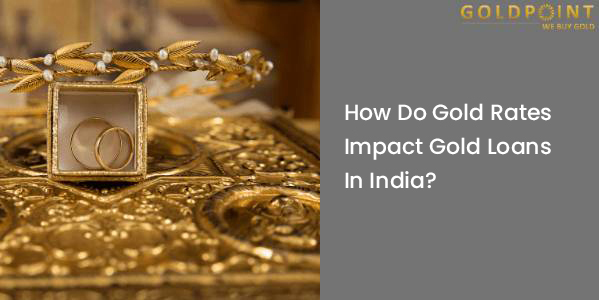
- ജൂണ്, 05 2023
- | Sell Gold
How Do Gold Rates Impact Gold Loans In India?
If you’re looking to take a gold loan, it is important you understand the factors that will affect the consequent costs you’ll have to bear. Naturally, the going gold rates in the country are the major determinant when it comes to determining loans against gold.
This blog post will explore the relationship between gold rates and gold loans in India while also providing tips for getting the best deals when borrowing. Before moving further, let us look at how the rates are calculated using the gold rate calculator.
The Per-Gram Rate for Gold Loan?
It refers to the amount lenders give for every gram of pledged gold. These rates differ from one lender to another, depending on their policies.
To calculate the per-gram gold rate for a gold loan, you can divide the loan amount by the weight of your gold in grams. For example, if you have 100 grams of gold and are eligible for a loan of Rs. 50,000, the per gram rate would be Rs. 500 (50,000 / 100).
Additional Read:How Gold Rate Fluctuation Affect the Indian Economy
What Are the Factors That Affect Gold Prices in India?
Gold has been an integral part of Indian culture. People buy gold not just as an investment but also for its cultural value. It is considered an auspicious metal, and people pass it on from one generation to another as a symbol of heritage.
As a result, it has always been chief among premium metals, and always in high demand. Apart from being expensive for its limited quantity and high value; the price of gold is also influenced by several other factors, some of which are discussed below.
Global Demand and Supply
Inflation
Interest Rates
Government Gold Reserves
How Does Gold Rate Impact a Gold Loan Application?
A Gold Loan depends on the current market value of gold, known as the gold rate. Here are a few ways gold rates affect Gold Loan applications.
1. Loan Amount
As mentioned previously, the per-gram rate for a gold loan is based on the current market value of gold.
You can borrow more cash for gold assets if the market prices are high. On the other hand, if the price is low, it decreases the lending limit.
2. Impact on Interest Rates
Gold loans, generally, have lower interest rates than other types since gold serves as collateral. However, the interest rate may vary depending on the gold rate.
When the gold rate is high, the interest rates are lower as the higher value of the collateral diminishes the risk.
In contrast, if the gold rate is low, lenders may charge higher interest rates to compensate for the increased risk.
3. Loan Tenure
Gold rates may also affect loan tenure. A higher gold rate will allow for a longer tenure, while a lower gold rate will lead to a shorter one.
4. Collateral Requirements
Besides the per gram rate, a lender may only ask for minimal collateral for approving gold loans. A lender’s requirements may depend on the gold’s weight, purity, and market value.
The lender may require less gold as collateral if gold is in high demand. However, if the gold price is low, the borrower has to pledge more gold as collateral to compensate.
Conclusion
Keeping track of the gold rate is imperative for anyone looking to take on a Gold Loan as it affects the amount, interest rate, and tenure. It’s always a good idea to compare offers from several lenders before settling on one. You can also jump online and take a look at gold rate forecasts and gold price prediction charts in India to better compare the going rates.
Also, if you are considering buying and selling gold online, you can always come to Muthoot Gold Point. We have a proven track record, transparent pricing, and secure payment and delivery options. It is essential for you to factor in these things when deciding whether a gold loan is right for you and negotiating the best deal.










